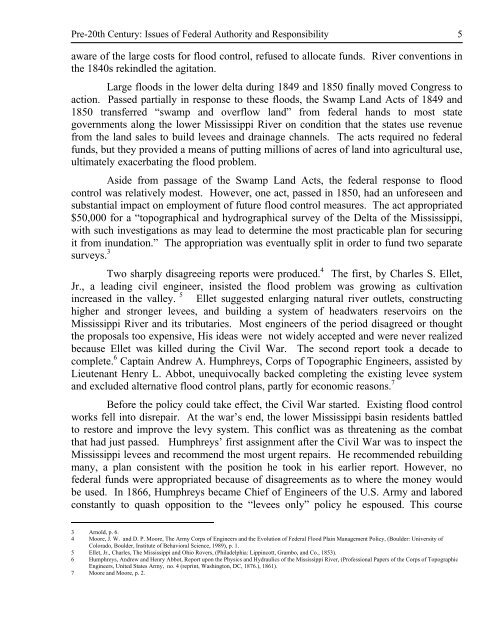The Nation's Responses To Flood Disasters: A Historical Account
The Nation's Responses To Flood Disasters: A Historical Account
The Nation's Responses To Flood Disasters: A Historical Account
Create successful ePaper yourself
Turn your PDF publications into a flip-book with our unique Google optimized e-Paper software.
Pre-20th Century: Issues of Federal Authority and Responsibility 5<br />
aware of the large costs for flood control, refused to allocate funds. River conventions in<br />
the 1840s rekindled the agitation.<br />
Large floods in the lower delta during 1849 and 1850 finally moved Congress to<br />
action. Passed partially in response to these floods, the Swamp Land Acts of 1849 and<br />
1850 transferred “swamp and overflow land” from federal hands to most state<br />
governments along the lower Mississippi River on condition that the states use revenue<br />
from the land sales to build levees and drainage channels. <strong>The</strong> acts required no federal<br />
funds, but they provided a means of putting millions of acres of land into agricultural use,<br />
ultimately exacerbating the flood problem.<br />
Aside from passage of the Swamp Land Acts, the federal response to flood<br />
control was relatively modest. However, one act, passed in 1850, had an unforeseen and<br />
substantial impact on employment of future flood control measures. <strong>The</strong> act appropriated<br />
$50,000 for a “topographical and hydrographical survey of the Delta of the Mississippi,<br />
with such investigations as may lead to determine the most practicable plan for securing<br />
it from inundation.” <strong>The</strong> appropriation was eventually split in order to fund two separate<br />
surveys. 3<br />
Two sharply disagreeing reports were produced. 4 <strong>The</strong> first, by Charles S. Ellet,<br />
Jr., a leading civil engineer, insisted the flood problem was growing as cultivation<br />
increased in the valley. 5 Ellet suggested enlarging natural river outlets, constructing<br />
higher and stronger levees, and building a system of headwaters reservoirs on the<br />
Mississippi River and its tributaries. Most engineers of the period disagreed or thought<br />
the proposals too expensive, His ideas were not widely accepted and were never realized<br />
because Ellet was killed during the Civil War. <strong>The</strong> second report took a decade to<br />
complete. 6 Captain Andrew A. Humphreys, Corps of <strong>To</strong>pographic Engineers, assisted by<br />
Lieutenant Henry L. Abbot, unequivocally backed completing the existing levee system<br />
and excluded alternative flood control plans, partly for economic reasons. 7<br />
Before the policy could take effect, the Civil War started. Existing flood control<br />
works fell into disrepair. At the war’s end, the lower Mississippi basin residents battled<br />
to restore and improve the levy system. This conflict was as threatening as the combat<br />
that had just passed. Humphreys’ first assignment after the Civil War was to inspect the<br />
Mississippi levees and recommend the most urgent repairs. He recommended rebuilding<br />
many, a plan consistent with the position he took in his earlier report. However, no<br />
federal funds were appropriated because of disagreements as to where the money would<br />
be used. In 1866, Humphreys became Chief of Engineers of the U.S. Army and labored<br />
constantly to quash opposition to the “levees only” policy he espoused. This course<br />
3 Arnold, p. 6.<br />
4 Moore, J. W. and D. P. Moore, <strong>The</strong> Army Corps of Engineers and the Evolution of Federal <strong>Flood</strong> Plain Management Policy, (Boulder: University of<br />
Colorado, Boulder, Institute of Behavioral Science, 1989), p. 1.<br />
5 Ellet, Jr., Charles, <strong>The</strong> Mississippi and Ohio Rovers, (Philadelphia: Lippincott, Grambo, and Co., 1853).<br />
6 Humphreys, Andrew and Henry Abbot, Report upon the Physics and Hydraulics of the Mississippi River, (Professional Papers of the Corps of <strong>To</strong>pographic<br />
Engineers, United States Army, no. 4 (reprint, Washington, DC, 1876.), 1861).<br />
7 Moore and Moore, p. 2.
















